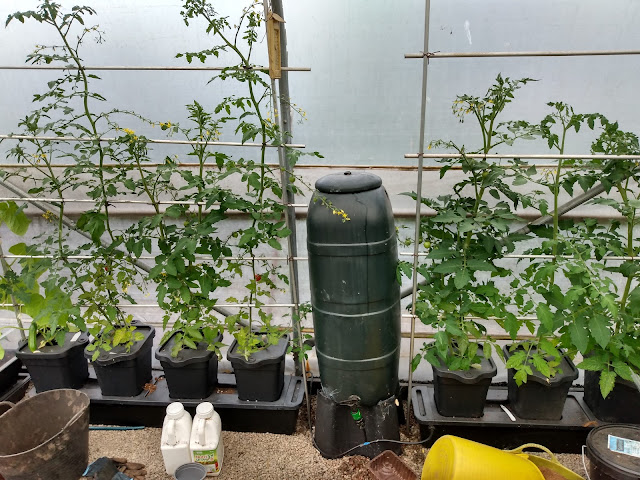 |
| Quadgrow Self-Watering System The Quadgrow Self-Watering System, supplied by Greenhouse Sensation, comprises three components - a reservoir for holding the aqueous plant-nutrient solution, a pot containing the growing medium (and the plant, obviously!), and a capillary wick connecting these two elements. The Quadgrow System could be considered a halfway house between conventional soil-based horticulture and hydroponics. While still using a growing medium akin to soil, it employs dilute water-soluble nutrient solutions to constantly feed and hydrate the growing plants. In terms of efficient water and nutrient use and maximum product yields, hydroponics is the preferred system. It is more expensive to set up and requires specialized techniques for preparing the plants (germination and growing without soil) albeit with the promise of greater yields and fewer pests. Compared with conventional soil-based horticulture, the Quadgrow system offers improved yields, fewer pests/diseases, and more efficient use of water/fertilizer without the need for the specialized plant preparation techniques required in hydroponics. For the amateur gardener, a Quadgrow Self-Watering System offers a number of benefits compared with conventional soil-based horticulture: (i) less frequent watering (leaving more time for other things and guaranteed holiday watering) (ii) more consistent watering (reduced tomato split/cracking) (iii) plants are watered from the base reducing the likelihood of bacterial canker & fungal diseases (iv) regular/consistent feeding (fewer problems such as blossom end rot) (v) optimized nutrient supply for plant development, flowering, fruit set, etc (better yields, healthier plants) (vi) improved root development (healthier more vigorous plants) (vii) use of commercial compost media (instead of garden soil) reduces pest/disease problems and avoids the need for crop rotation (viii) significantly higher fruit/vegetable yields (expect at least double) Accessories for the Quadgrow include: (i) pot lids/mulch caps (see photo above) to reduce evaporation from soil and lengthen times between reservoir top-ups; the lids also have holes to hold canes to build your own plant support system (ii) a holiday watering kit comprising 80L water butt, ballcock valve for the reservoir to maintain constant water/nutrient level plus associated tubing and connectors (see above photo) - go on holiday for a week/fortnight without worrying whether your plants will be dead when you get back! (iii) clear plastic domes/greenhouses for extra frost protection (also useful in the garden for protecting single plants) - see picture below: (iv) solar conversion kits to move even closer to that hydroponic future - not for me as I'm already fully invested in the older incompatible kit Greenhouse Sensation also do a range of Salad/Vegetable Planters that work on the same principle - water/nutrient reservoir, planter with 'soil' & plants, and connecting wicks. They come in two sizes: standard/medium (55 cm (L) x 55 cm (W) x 25 cm (H)) and large (105 cm (L) x 55 cm (W) x 25 cm (D) - note the depth measurement includes the resevoir; soil depth is 15 cm. Accessories include modular greenhouse sections (with adjustable ventilation) and lid (also with adjustable ventilation). Unfortunately, there is no 'holiday kit' to extend the times between reservoir top-ups. I grow salad leaves, radish, lettuce, pak choi, celery, celeriac, chilli peppers, sweet peppers, aubergines and more in these planters both outside and in the polytunnel. Not to mention the bog garden! I have found that sweet & chilli peppers and aubergines grow better in the salad/veg planters than in the Quadgrows. I don't know if this was because the peppers/aubergines did not like being grown next to tomatoes and cucumbers (i.e. in the same Quadgrow) or whether they just preferred closer planting with their own kind in a salad/veg planter. Aubergines and peppers (chilli & sweet/bell) seemed happy to grow together. In the next post, I'll discuss preparing and setting up the Quadgrow. |








0 comments:
Post a Comment